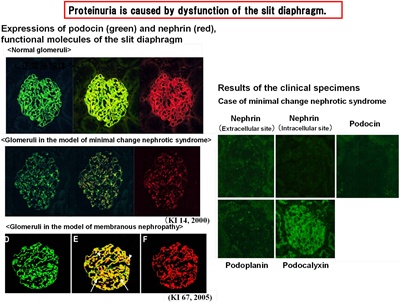1.Research Summary
The Department of Cell Biology is engaged in ongoing research aimed at understanding the mechanisms underlying the pathogenesis and progression of renal glomerular diseases, in order to develop new therapies. In particular, our efforts are focused on elucidating the pathogenic mechanisms of proteinuria, the development of new treatments for nephrotic syndrome, and elucidation of the pathogenic mechanisms underlying glomerular sclerosis in order to decrease the annually increasing number of the patients with chronic renal failure.
2.Research subjects
3.Research Results
[Area] Cell Biology
[Research subject]
Alteration of the molecular structure of the slit diaphragm and its role in the development of proteinuria
[Description]
We have analyzed the molecular structure of the slit diaphragm and elucidated
that reduced expressions and altered interactions of the slit diaphragm
molecules contribute to the development of proteinuria in minimal change
nephrotic syndrome, focal segmental glomerulosclerosis, and membranous
nephropathy.
[Photographs]

[Area] Cell Biology
[Research subject]
Regulatory mechanisms of expressions of slit diaphragm molecules by the renin-angiotensin system
[Description]
Although it has been demonstrated that angiotensin II (Ang II) receptor
blocker (ARB) reduces proteinuria, the mechanism has not been understood.
Based on the results from the experiments using cultured podocytes and
the analyses in the experimental model of proteinuria, we showed that stimulation
of Ang II type 1 receptor (AT1R) in podocytes in response to Ang II reduced
the expressions of nephrin and podocin, the critical components of the
slit diaphragm, whereas stimulation of Ang II type 2 receptor (AT2R) enhanced
these expressions. These findings suggest that the Ang II receptor blocker
suppresses proteinuria by preventing reduced expressions of slit diaphragm
molecules.
Look at reference materials
[Photographs]

[Area] Cell Biology
[Research subject]
Transport mechanisms of slit diaphragm molecules by synaptic vesicles
[Description]
We have demonstrated that synaptic vesicle protein 2B (SV2B), a synaptic
vesicle-associated molecule, is expressed in podocytes and that decreased
expression is detected before the onset of proteinuria. In order to clarify
the role of SV2B in the development of proteinuria, we examined the expression
and localization of CD2AP, a functional molecule of the slit diaphragm,
in SV2B knockdown cultured podocytes. The localization of CD2AP was altered,
that is, CD2AP staining was not detected at the process area, where it
is normally observed. These results suggest that SV2B may be involved in
intracellular transport of CD2AP and contribute to the normal localization
of CD2AP. At present, we are generating SV2B knockout mice and analyzing
these functions.
Look at reference materials
[Photographs]

Please see the Cell Biology website for a detailed description of our research.
